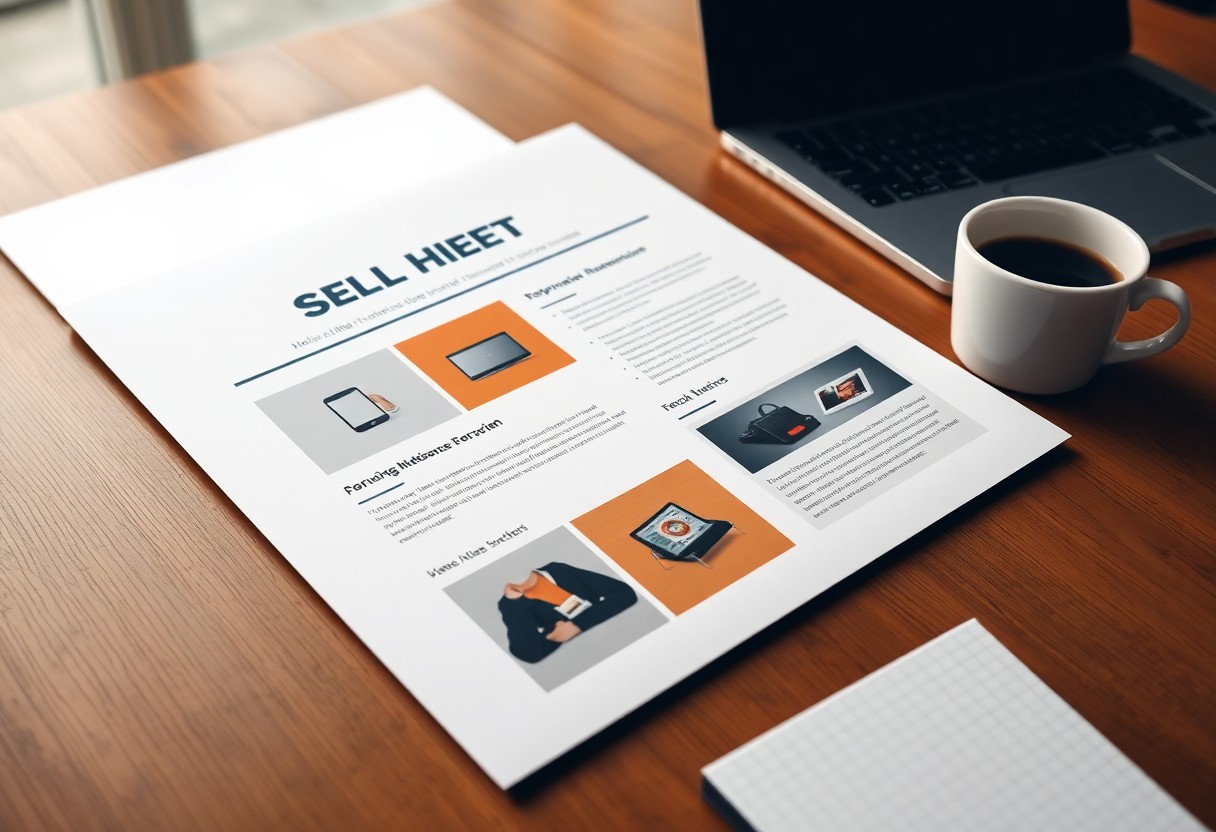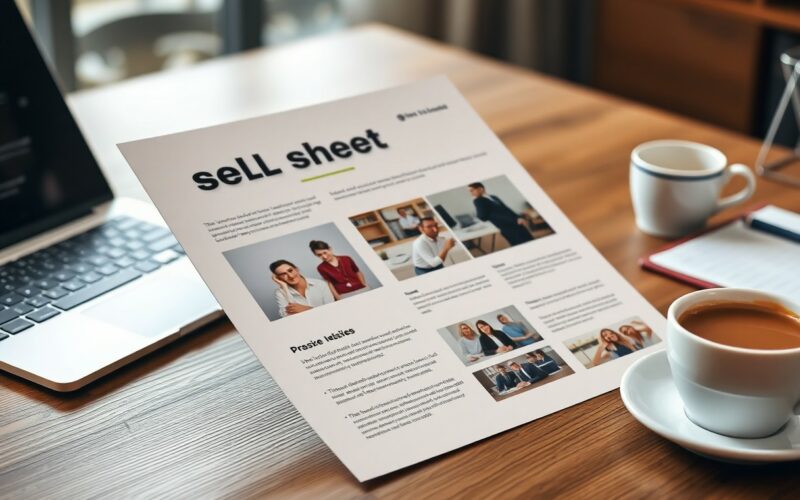Sheet music may help you play the right notes, but a sell sheet acts as your marketing score, outlining what makes your product or service irresistible. In this post, you will discover what a sell sheet is, its key components, and how to design one that captivates your target audience. Whether you’re pitching to potential clients or showcasing a new product, you’ll learn the vitals to effectively communicate your value and drive sales. Get ready to create a powerful tool that can elevate your marketing strategy and yield outstanding results.

Understanding Sell Sheets
While crafting marketing materials, it’s crucial to grasp what a sell sheet is and how it can impact your promotions.
Definition of a Sell Sheet
Above all, a sell sheet is a one-page document created to promote your product or service clearly and effectively. It highlights key features, benefits, and crucial information to persuade potential buyers, making it an invaluable tool in your marketing arsenal.
Importance of a Sell Sheet in Marketing
Along with your other marketing efforts, a well-designed sell sheet plays a significant role in attracting attention and providing concise information. It serves as a quick reference for potential clients and decision-makers, helping them understand your offering at a glance.
But the role of a sell sheet extends beyond just being informative. It acts as a first impression for your product and can set the tone for how potential customers perceive your entire brand. Having a well-crafted sell sheet can effectively influence their purchasing decisions.
Key Elements of a Successful Sell Sheet
Definition is vital when discussing the crucial elements of a successful sell sheet, which typically includes compelling visuals, a catchy headline, key benefits, and contact information. Each of these aspects must work together to convey your message clearly.
Sheet design matters just as much as the content. Focus on creating a visually appealing layout that makes the crucial elements stand out. Attention to detail in your choice of colors, fonts, and images can create an engaging feel that resonates with your target audience. Your goal is to entice potential customers to take action, whether that’s visiting your website, calling for more information, or making a purchase.

Designing Your Sell Sheet
There’s no denying that design plays a vital role in creating an effective sell sheet. A well-designed sell sheet not only grabs attention but also communicates your message clearly and effectively. Your aim should be to provide potential customers with a visually appealing and informative tool that showcases your product or service.
Layout and Format Considerations
After deciding on the type of content you’ll include, focus on the layout and format. Ensure that your sell sheet has a clean design that maintains a logical flow of information. Use headings, subheadings, and bullet points to break down the text and make it easy to skim.
Choosing the Right Graphics and Images
Sheet visuals are compelling and can significantly enhance the impact of your sell sheet. Choose images that resonate with your brand and association and effectively highlight your product’s features. Aim for high-quality graphics that complement your message and evoke the right emotions for your audience.
Typography and Color Schemes
Sell the story of your brand through thoughtful typography and color schemes. Select fonts that are easy to read and align with your brand personality. Choose a color palette that reflects your message and appeals to your target audience to enhance the overall aesthetics.
Typography and Color Schemes (Expanded)
Before finalizing your design, consider how the font styles and colors will influence your audience’s perception of your product. Use bolder fonts for headings to grab attention, while maintaining readable text sizes for body copy. Color schemes should be cohesive; opt for contrasting colors to highlight key sections and ensure they are easy on the eyes to create a visually appealing balance.
Content Creation
Many people underestimate the importance of content creation when it comes to crafting a sell sheet that truly pops. The way you present your product or service through effective language and visuals can mean the difference between capturing attention or being overlooked. Careful attention to detail and strategic writing can help you connect with your target audience.
Crafting an Engaging Headline
Headline writing is an art form that can make or break your sell sheet. You want to create a compelling phrase that grabs your audience’s attention and succinctly communicates the essence of your offer. A well-crafted headline should evoke curiosity and encourage readers to learn more.
Writing a Compelling Overview
One of the most vital elements of your sell sheet is the overview. This section serves as your product’s elevator pitch, outlining what it is and why it matters. It should be clear, concise, and designed to encourage the reader to probe deeper into the features and benefits.
Also, think of your overview as the gateway to your sell sheet. You want to include key selling points, such as how your product solves a problem or meets a need. Aim for a few captivating sentences that set the tone for the rest of your content.
Highlighting Key Features and Benefits
To truly engage your audience, it’s important to highlight the key features and benefits of your product. This section will help clarify why your offer stands out in the market:
- Unique features: Identify what makes your product different.
- Benefit-driven language: Explain how these features can improve the user’s experience.
- Problem-solving capability: Showcase how your product addresses common issues faced by your audience.
Thou should focus on presenting clear, impactful information that speaks directly to the needs of your potential customers.
It’s also vital to intertwine features with benefits, illustrating the value that each aspect brings to the user. Show how the specifics of your product translate into a better experience, potentially increasing its desirability.
Including Testimonials and Case Studies
Including testimonials and case studies adds credibility to your claims, establishing trust with your readers. When prospective customers see that others have benefited, they’re more likely to believe in the value you’re presenting.
Including concrete examples strengthens your messaging. Consider these case studies to include in your sell sheet:
- Case Study 1: 95% customer satisfaction rate after using our product for three months.
- Case Study 2: Increased productivity by 30% in companies that implemented our solution.
- Case Study 3: Reduced costs by 20% through improved efficiency.
Features that highlight success stories help convey a powerful message about the effectiveness of your product.
Designing a Call to Action
With a strong call to action (CTA), you direct the reader on the next steps they should take. A well-conceived CTA can significantly enhance your sell sheet’s effectiveness.
At the conclusion of your sell sheet, you want to offer clear instructions on how to proceed. Whether it’s contacting you for more information, signing up for a free trial, or making a purchase, ensure your CTA is persuasive and visually distinct. Incorporating strong action words can compel readers to take the desired next step.

Tailoring Your Sell Sheet for Different Audiences
All effective marketing starts with a deep understanding of your audience.
Understanding Your Target Market
Sell sheets can vary significantly depending on your target market. By identifying the demographics, needs, and motivations of your potential clients, you can design a sell sheet that speaks directly to their interests. Take the time to research your audience’s preferences and pain points, as this insight will inform the overall messaging and structure of your sell sheet.
Customizing Content for Potential Clients
Against a backdrop of many competing products, crafting specific content for each potential client enhances your chances of capturing their interest.
Your sell sheet should include tailored details that appeal directly to the client’s unique needs and goals. Highlight the benefits most relevant to them, and incorporate case studies or testimonials that resonate with their industry or situation. This personalized approach can make your offering feel more relevant and valuable, increasing the likelihood of a favorable response.
Adjusting Tone and Language
Your tone and language play a significant role in how your sell sheet is perceived.
Your choice of words should reflect the personality and preferences of your audience, whether professional and formal or casual and approachable. Tailoring the tone not only makes your sell sheet more relatable but also builds a connection with the reader. Ensure that your language is clear and concise while effectively communicating the value of your product or service in a way that engages your audience.
Audiences respond well to personalized messaging. By focusing on their specific needs and preferences, you can better engage with them. Every detail you tailor, from content to tone, should serve to underscore how your product or service can solve their problems and improve their situation, making your sell sheet not just informative but compelling and persuasive.
Distributing Your Sell Sheet
Once again, distribution plays a vital role in the effectiveness of your sell sheet. To ensure your messaging reaches the right audience, you might find it helpful to refer to resources like What Is a Sell Sheet? (With Benefits and How To Write One).
Choosing the Right Distribution Channels
Choosing the appropriate channels to distribute your sell sheet can significantly impact your outreach efforts. Consider your target audience and where they are likely to be present. Whether you decide on direct mail, email marketing, or social media, selecting the right channels ensures your sell sheet reaches those most interested in your offering.
Digital vs. Print Sell Sheets
Right from the start, it’s crucial to weigh the benefits of digital versus print sell sheets. Digital sell sheets can be easily shared via email or social networks, while print sell sheets offer a tangible connection during face-to-face interactions.
Digital sell sheets allow for easy updates and quick distribution, making them ideal for businesses that need to adapt their messaging rapidly. On the other hand, print sell sheets can leave a lasting impression, particularly during trade shows or in-person meetings. Integrating both formats into your strategy might help you maximize your reach and appeal to varying preferences among your audience.
Follow-up Strategies for Maximizing Impact
Followup strategies serve as a critical component in ensuring your sell sheet makes a lasting impression. After sending out your sell sheet, keep track of your contacts and be proactive in reaching out to gauge interest or answer questions.
Channels that are utilized for follow-up can deepen your connection with prospects. Consider using personalized emails, phone calls, or even social media messages to reinforce your initial outreach. A thoughtful follow-up can increase your chances of converting leads into customers, leaving a positive impact that stands out amidst a sea of competing offers.
Measuring the Effectiveness of Your Sell Sheet
Despite putting in countless hours of effort to create a compelling sell sheet, you need to measure its effectiveness to ensure it is achieving the desired results. Understanding how it performs can guide you in making informed adjustments that enhance its impact on potential customers.
Key Performance Indicators (KPIs)
Before you assess the success of your sell sheet, identify your key performance indicators (KPIs). These metrics could include click-through rates, conversion rates, or the number of responses received. Establishing clear KPIs allows you to evaluate whether your sell sheet is hitting the mark.
Collecting Feedback and Making Improvements
Between gauging your KPIs, obtaining feedback from your audience is necessary to refine your sell sheet. Engaging with customers or colleagues can provide insights on what works and what doesn’t. Their perspectives can elucidate areas needing enhancement, ensuring your sell sheet appeals effectively.
Due to the subjective nature of selling, feedback from real potential customers is invaluable. Consider conducting surveys or interviews to gather specific insights on the content, layout, and overall messaging of your sell sheet. Implement changes based on this feedback to elevate its persuasiveness, ultimately enhancing your sales results.
A/B Testing Your Sell Sheet
Sell one version of your sell sheet against another version to identify which resonates more with your audience. A/B testing allows you to compare elements such as headlines, visuals, and calls to action effectively.
Understanding the subtle nuances that can sway potential clients is an necessary part of A/B testing. By iterating your design and messaging, you can identify what elicits the best response. Monitor which version drives more engagement and conversions, and use this information to inform your future sell sheet strategies.
To wrap up
As a reminder, a sell sheet is a powerful marketing tool that succinctly presents your product to potential clients or retailers. To create one that effectively sells, focus on clarity, compelling visuals, and persuasive language that highlights the benefits of your offering. Include strong calls to action and ensure your contact information is clearly visible. By mastering these elements, you’ll create a sell sheet that not only captures attention but also drives interest and sales, helping you achieve your marketing goals.
FAQ
Q: What is a Sell Sheet?
A: A sell sheet is a one-page document used primarily in sales and marketing that summarizes a product or service’s key features, benefits, and pricing. It serves as a promotional tool designed to persuade potential buyers or retailers to make a purchase or agree to promote your offerings.
Q: Why is a Sell Sheet important for my business?
A: A sell sheet is important because it acts as a concise and persuasive pitch for your product or service. It helps establish your brand’s identity, outlines the unique selling propositions, and can generate leads. It is often one of the first materials a potential buyer encounters, making it vital for capturing interest quickly.
Q: What crucial elements should be included in a Sell Sheet?
A: Essential elements of a sell sheet include:
- Product or Service Name: Clearly indicate what you are offering.
- High-Quality Images: Visuals improve engagement and interest.
- Key Features and Benefits: Briefly outline what makes your offering unique.
- Target Audience: Describe who would benefit from your product.
- Pricing Information: Provide pricing or purchasing options to instill trust.
- Contact Information: Make it easy for potential buyers to reach out for more details.
Q: How do I design an effective Sell Sheet?
A: To design an effective sell sheet, use a clean layout with eye-catching headings and an organized structure. Utilize high-quality images to draw attention and ensure that the text is concise and engaging. Use bullet points for key information and incorporate your branding elements like logos and colors to create a professional look.
Q: Who should I target with my Sell Sheet?
A: The target audience for your sell sheet primarily includes potential customers, retailers, distributors, and partners. Understanding your audience will help tailor the content and messaging so that it resonates with their specific needs and interests.
Q: Can a Sell Sheet be used for digital marketing?
A: Yes, a sell sheet can be effectively used for digital marketing. It can be converted into a PDF to be shared via email, on social media, or as downloadable content on your website. This allows for wider reach and easier distribution while maintaining the core objective of promoting your product or service.
Q: How can I evaluate the effectiveness of my Sell Sheet?
A: To evaluate the effectiveness of your sell sheet, track metrics such as engagement rates, conversion rates, and feedback from recipients. You can also conduct surveys or gather testimonials from your audience to assess whether your sell sheet is successful in conveying the intended message and stimulating interest in your product or service.


![10 Must-Have AI Tools for Startups & Small Businesses [2026]](https://smartgeekguide.com/wp-content/uploads/2025/10/top-10-ai-tools-for-startups-2026-xmg-360x240.jpg)






